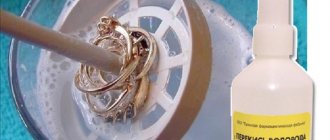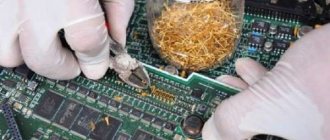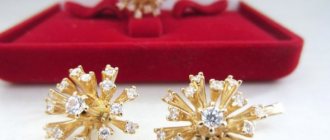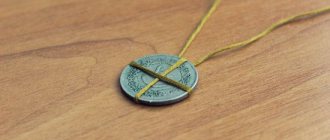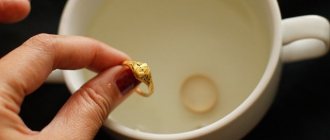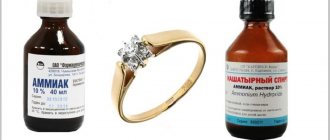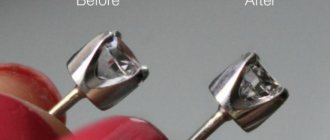What it is
Ancient scientists admired gold and believed that it was the best metal of all - the king of metals. Therefore, when alchemists discovered a liquid capable of dissolving it, they called it aqua regia (royal water). In Russian at that time, liquid reagents were called vodka. This is where the name royal vodka comes from.
This is a strong solvent that reacts even with many inert metals (gold, platinum, ruthenium). It has an orange color and a pungent odor of nitrogen dioxide and chlorine.
What does it consist of?
The royal reagent suitable for dissolving gold consists of a mixture of nitric and hydrochloric acids in a ratio of 1:3. Reagents with mass concentrations of 68% and 35%, respectively, are used.
When the components are combined, highly active substances are formed: nitrogen dioxide, chlorine and nitrosyl chloride:
НNO3 + 3НCl = Сl2 + NOСl + 2Н2О 2NOCl = 2NO + Сl2 2NO + О2 = 2NO2
How to make your own aqua regia
To prepare aqua regia, combine 3 parts hydrochloric acid with 1 part nitric acid. It is necessary to mix the components only before use, since during storage, volatile products evaporate, reducing the activity of the solvent.
Dissolution of gold is also possible in hydrochloric acid, but the reaction rate is low. Nitrogen acts as a reaction catalyst. Therefore, you should first pour HCl into a glass container and place gold-containing objects in it. And only now gradually add nitrogen.
It is important not to overfill the nitrogen, as this will complicate the process of Au precipitation from the solution.
Precipitation and its essence
Precipitation of gold with iron sulfate is carried out when the precious metal is a mixture of aqua regia and a noble element. The color of the liquid may vary; chemists note that the metal dissolved in aqua regia may become cloudy. But there is no need to worry about this.
Gold precipitation
Iron sulfate is just one of the elements that can be used in precipitation. But in most cases it is used due to its availability. At its core, ferrous sulfate is a powder that has a yellow or greenish tint and is used by chemists and doctors because it is also a medicine.
Precipitation is the separation of Au from solution; If the procedure is carried out using ferrous sulfate, then a certain sequence should be followed:
- It is recommended to dissolve iron sulfate in water, keeping the proportions one to two: one part vitriol and two parts water. If the liquid has changed color, darkened or become cloudy, then nails must be added to it. Clean iron nails will help restore transparency to the solution; usually add five grams of nails per 100 grams of already prepared solution.
- Since aqua regia is a mixture of hydrochloric and nitric acids, refining begins by evaporating the excess nitric acid under a hood. It is recommended to use a hood during the process. To evaporate excess nitric acid from the solution, you need to heat the aqua regia. It should be poured into a porcelain bowl and put on fire; during the refining process, use not only iron sulfate, but also sodium chloride. This element will help prevent the breakdown of nitrogen chloride.
- As the solution heats up, it is advisable to stir it with a special glass stick. You also need to stock up on hydrochloric acid: as it evaporates, it is gradually added to the solution.
- When the consistency of the solution begins to resemble thick jelly or suspension, it must be removed from the heat and cooled. After the solution has cooled, hydrochloric acid is added to it again.
- The next stage is filtering. It is worth adding iron sulfide from which the solution was previously prepared to the filter.
- If everything is done correctly, the gold contained in the mixture of reagents will turn into a red or orange precipitate. It will be a powder, which is called "heavy" because the sediment remains at the bottom of the vessel. It is clearly visible.
But the deposition of gold does not end there. It is necessary to collect the sediment, rinse it under a stream of water and dry it using a paper filter. When the particles are dry, the filter is burned or thrown away, and the powder that was obtained during the refining process is the gold that was previously dissolved in aqua regia. The amount of impurities in the precious metal is not too large; it is often possible to obtain gold of a high standard.
The deposition can be considered complete at this point. But the resulting Au particles must be melted into an ingot or small piece.
But precipitation is carried out not only using iron sulfate; other substances can also be used.
Step-by-step instructions on how to dissolve gold in aqua regia at home
Precautionary measures
During the reaction, toxic gases (NOCl, Cl2, NO, NO2) are released, which can lead to pulmonary edema and death. All work must be carried out outdoors or in laboratories with a good exhaust ventilation system. Use a respirator and protect your body and eyes from contact with caustic reagents. Actions must be as careful as possible to eliminate the risk of reagent spills.
Gold preparation
Gold-containing items must be cleared of plastic before dissolution. Other impurities can be removed with nitric acid.
Uncleaned parts quickly contaminate the aqua regia and complicate the gold extraction process. This is why pre-cleaning is carried out.
After cleaning mechanically and with nitrogen, the remaining metals in the container should be filled with HCl. A noticeable reaction will begin, indicating that the remaining impurities have dissolved. After the reaction stops, drain the reagent and add a new portion of HCl.
Next, heat the mixture and gradually add nitric acid. It doesn't have to be completely spent. If the dissolution of gold has stopped, stop adding HNO3 and leave the heated composition for 30 minutes.
Filtration of the solution
After standing, we clean the solution through filter paper and again leave to stand for 20-30 minutes. Most of the volatile components will evaporate and evaporation will take less time.
Then you should add sulfuric acid in a volume of 5 ml per 100 ml of solution and begin to evaporate the aqua regia. The reagent will precipitate the remaining silver and lead, and will also speed up the removal of HNO3.
The solution should be evaporated carefully, heating slowly, but not boiling. When it becomes syrupy, add more hydrochloric acid and evaporate further.
This cycle can be repeated 2-3 times.
Then add HCl again to the original consistency, and dilute the resulting mixture with water in a 1:1 ratio. Keep the solution in a cool place for 24 hours. The remaining silver chloride will settle to the bottom.
Now carefully filter the solution to get rid of sediment and turbidity.
Gold precipitation
The following reagents can be used to isolate gold from a liquid:
- hydrazine (must be added drop by drop, otherwise it may explode);
- inkstone;
- sodium pyrosulfite;
- oxalic acid;
- sodium sulfite;
- hydrogen peroxide.
The simplest, safest and cheapest method is precipitation using iron sulfate. The chemical reaction equation is:
HAuCl4 + 3FeSO4 = Fe2 (SO4) 3 + FeCl3 + HCl + Au
We take vitriol in the amount of 14 g per 1 g of expected gold. Dissolution is carried out in warm water with the addition of hydrochloric acid. Then we pour it all into a flask with gold.
If the liquid does not become cloudy, but hisses, then there is too much HNO3 left in it. In this case, you should add iron sulfate in small portions until the hissing stops.
The resulting mixture is kept for 24 hours to allow precipitation to complete.
The next day, the solution must be filtered. The resulting brown precipitate is gold sand. We wash it with HCl. This will remove any remaining iron. Then you can rinse with ammonia to remove copper impurities. Finally, rinse with hot water several times.
The gold can now be melted and poured into a mold to make an ingot or into cold water to form gold granules.
This method allows you to obtain 999 fine gold.
Waste gold recovery
Gold in many solutions has a positive potential value, but in cyanide electrolytes the potential of gold (negative) becomes greater than that of silver.
Au + 2CN- = Au(CN)-2+ ē
(φ = - 0.6 V);
Ag + 2CN- = Ag(CN)-2+ē
(φ= -0.31 V);
Au + 4Сl- = AuCl-4 +3ē (φ = 1.0 V).
This property of gold is used in most cases to remove low-quality coatings from parts made of copper, nickel and their alloys. The solution contains NaCN (120 g/l) and H2O2 (35 ml/l), the solution temperature is room temperature. Hydrogen peroxide is added to the solution in small portions immediately before removing the coating.
Gold is removed from steel and brass in solution (in g/l):
Cyanide ferrate 50
Potassium cyanide 20
Potassium carbonate 10
Potassium acid phosphate to pH = 9
Removal mode: solution temperature 45-50°C, voltage 2.5 - 3 V, cathode made of platinized titanium or gold. From cyanide solutions (after removing the poor-quality coating) or waste electrolytes, gold is recovered at the cathode (the conditions are the same as for gilding) or isolated using zinc or aluminum powder. The resulting precipitate is treated with hydrochloric acid to convert it into a zinc solution, and then with nitric acid to remove impurities of silver and copper. The washed sediment is used as returnable waste.
Gold coatings removed in aqua regia; evaporate and dilute with water. Then iron sulfate, acidified with HCl, is added to the solution until a precipitate of gold precipitates in the form of a dark powder. This powder is used to prepare gold chloride.
Gold is deposited from the finally spent electrolyte as follows. NaOH is added to the electrolyte (up to 10% concentration), heated to 50 - 60 ° C and the reduction of gold is carried out by contact, gradually introducing aluminum strips into the solution (strip thickness <= 1 mm). The completion of restoration is checked by maintaining the shiny surface of the aluminum. The sediment is then fused with borax. With this regeneration method, irrecoverable losses amount to 0.012 - 0.022% of the total gold consumption.
Gold-copper alloy coatings are removed without damaging the base (brass and bronze) by anodic dissolution in H2SO4 (1.84). Lead is used as the cathode. With a coating thickness of 3 - 5 microns, the removal process ends in 15-20 minutes (ia = 3 ÷ 5 A/dm2). The end of alloy removal is determined by a voltage jump from 4 to 12 V. This method can also be used to remove pure gold.
Low-quality coatings with an Au-Ag-Cu alloy are removed in the same electrolyte composition in which this coating is deposited on serial parts. To do this, parts are loaded into a bell with a volume of 5 - 7 liters at the rate of 25 - 30 dm2 and the process is carried out without current while the bell rotates. Coating removal rate ~ 3 µm/h.
The gold content in the first collection-collector for gold electrolytes should be equal to 0.5 g/l, in the second <0.1 g/l, in the third traces are acceptable. The contents of the first collection are used to adjust the gilding electrolyte, and the contents of the remaining collections are evaporated to a dry residue.
Losses of gold, like other metals, when coating parts are applied can be divided into returnable and irrecoverable. Irreversible ones include those associated with the preparation of gilding electrolytes and their operation, as well as during the regeneration of gold from waste electrolytes, etc.
Returnable gold waste includes, for example, parts with low-quality gold or half gold, gold in the form of metal and crumbs from cathode balls, powder or salts from spent electrolytes, pieces of gold from anodes, etc. Returnable waste is planned for each enterprise depending on its specifics.
To regenerate gold from waste electrolytes, ion-exchange liquid-liquid extraction is used.
Trialkylamine is used as an extractant in the form of a 0.2 M solution in kerosene. The extractant solution is a lighter phase that is immiscible with the aqueous phase (electrolyte). When mixing the electrolyte and extractant, gold is completely extracted into the organic phase. As a rule, other metals present in the electrolyte do not pass into the organic phase. Thus, gold is not only extracted into the extractant, but at the same time purified from impurities.
Gold extraction, extractant washing and re-extraction are carried out in one ten-chamber extractor of the “mixer-settler” type. The movement of the aqueous and organic phases occurs in a multi-stage countercurrent. Both phases are mixed in the mixing chamber when turbine-type mixers rotate. The settling (separation) of phases is carried out in settling chambers.
The extractant saturated with gold is subjected to additional washing to remove impurities with a 10% sulfuric acid solution at a volume ratio of aqueous and organic phases of 7:1. From the saturated extractant, gold is transferred into a solution of potassium cyanide (30 - 40 g/l). This method is used to regenerate gold from waste electrolytes and wash waters. It allows almost complete use of gold in production.
